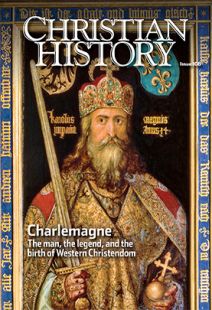Recommended resources
BEGIN EXPLORING Charlemagne’s life, the achievements of his reign, and his impact on European culture and religion with these resources recommended by CH editorial staff and this issue’s contributors.
BOOKS
• We are lucky to have a good English edition of two biographies written close to Charlemagne’s own time: that of Einhard, referred to many times in this issue, and that of the monk Notker the Stammerer who wrote 70 years after Charlemagne’s death. You can find them in Two Lives of Charlemagne in the Penguin Classics series, edited by medieval historian David Ganz.
• Modern biographies include Alessandro Barbero’s thorough Charlemagne: Father of a Continent; Matthias Becher’s concise Charlemagne; and another Charlemagne by Roger Collins that focuses on politics and culture.
• The intriguing Becoming Charlemagne by Jeff Sypeck puts Charlemagne into his historical context by imagining the lives of those around him, from Empress Irene in Constantinople to Isaac, the Jewish North African who brought Charlemagne’s elephant back from Baghdad.
• Find a good timeline of world events surrounding Charlemagne’s court in The World in the Time of Charlemagne by Fiona Macdonald. Read more on Christianity in this era in The Church in the Early Middle Ages, Faith in the Middle Ages, and The History of Christian Europe by G. R. Evans. And regarding why the Dark Ages may not have been as dark as once thought, check out Barbarians to Angels: The Dark Ages Revisited by Peter Wells.
• Do you want to know more about what they ate in the ninth century? The aptly named Daily Life in the Age of Charlemagne by John Butt and Daily Life in the World of Charlemagne by Pierre Riché will tell you that and more, as will Charlemagne and His World by Friedrich Heer. The Oxford Illustrated History of Medieval Europe and the Shorter Cambridge Medieval History are thorough, encyclopedic sources on every aspect of the early Middle Ages.
• The iconoclastic controversy profoundly affected Charlemagne’s relationships with the Byzantine Empire. Read more in Thomas F. X. Noble’s Images, Iconoclasm, and the Carolingians. Diverging views on Charlemagne’s relationship with Islam appear in Mohammed and Charlemagne by Henri Pirenne, Mohammed and Charlemagne Revisited by Emmet Scott, and Mohammed, Charlemagne, and the Origins of Europe by Richard Hodges.
• And dig into the achievements of the Carolingian Renaissance in Marcia Colish’s Medieval Foundations of the Western Intellectual Tradition, 400–1400; Jean Hubert’s The Carolingian Renaissance; and Carolingian Culture: Emulation and Innovation, edited by Rosamond McKitterick.
• Finally, The Song of Roland was crucial in turning Charlemagne’s life into legend. It can be read in translation in the Penguin Classics series, edited by Glyn Burgess, and in a more contemporary prose retelling by W. S. Merwin in the Modern Library series. Guides to reading it include Reading the Song of Roland by Eugene Vance and The Sense of the Song of Roland by Robert Francis Cook. Larger considerations of medieval legend are addressed in Christopher Fee’s Mythology in the Middle Ages: Heroic Tales of Monsters, Magic, and Might and Robert Morrissey’s Charlemagne and France: A Thousand Years of Mythology.
PREVIOUS ISSUES OF CHRISTIAN HISTORY
• Read back issues of Christian History magazines or purchase print copies of available issues at www.christianhistorymagazine.org. Most relevant to this issue’s theme are 30: Women in the Middle Ages 54: Eastern Orthodoxy: Then and Now 60: How the Irish Were Saved 74: Christians and Muslims 93: A Devoted Life (western monasticism)
• In addition, CH’s guide, The History of Worship from Constantine to the Reformation, “zooms in” on worship in the century before Charlemagne as one of its areas of focus.
VIDEOS FROM VISION VIDEO
• Check out the History of Christianity and History of Christian Worship series to put the early Middle Ages in perspective and Great Epochs of Christian Art to view art from many periods of the church, including Charlemagne’s.
WEBSITES
• You can read all sorts of texts from Charlemagne’s era (including both the Einhard and the Notker biographies) at the “Carolingians” section of Fordham’s Medieval History Sourcebook, www.fordham.edu/halsall/sbook1h.asp. Excerpts from texts specifically about his coronation can be found at pirate.shu.edu/~wisterro/coronation.htm.
• A lecture from the Ancient and Medieval History Guide about Charlemagne and the Carolingian Renaissance, with many pictures and links, is at www.historyguide.org. Or you can access a similar page from the History Channel at www.history.com/topics/charlemagne.
• The Medieval History section of About.com has a collection of images of Charlemagne in art, historymedren.about.com. Another collection is in the Encyclopedia Britannica’s article on Charlemagne, www.britannica.com, and even more are at Smart History (smarthistory.khanacademy.org) and at the Metropolitan Museum of Art (www.metmuseum.org). CH
By the Editors
[Christian History originally published this article in Christian History Issue #108 in 2014]
Next articles
The thousand lives of Charlemagne
How medieval poets turned a border skirmish into a foundational medieval legend
David A. Michelson“Father forgive them”
The persecution of Christians in modern history: staggering numbers, inspiring stories
Christof Sauer and Thomas SchirrmacherStart seeing persecution
How Westerners overlook persecution, what it looks like, and what we can do about it
The editors and Roy StultsTortured for Christ
Richard Wurmbrand stood for Christ behind the Iron Curtain. It cost him 14 years in prison
Merv KnightSupport us
Christian History Institute (CHI) is a non-profit Pennsylvania corporation founded in 1982. Your donations support the continuation of this ministry
Donate



